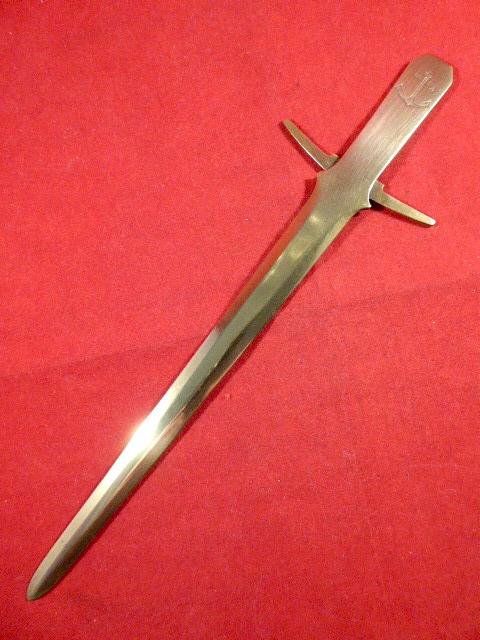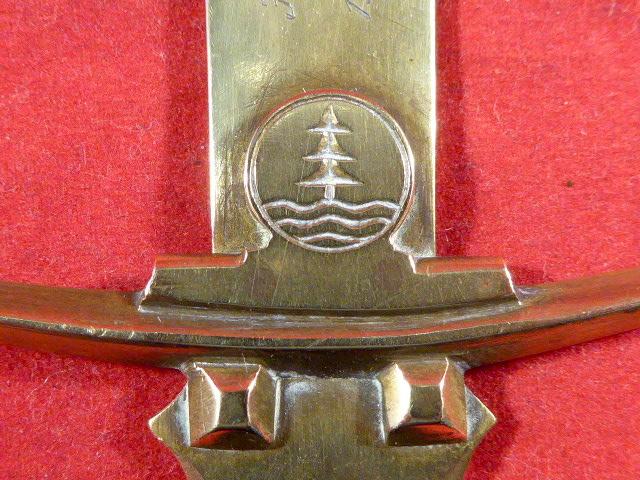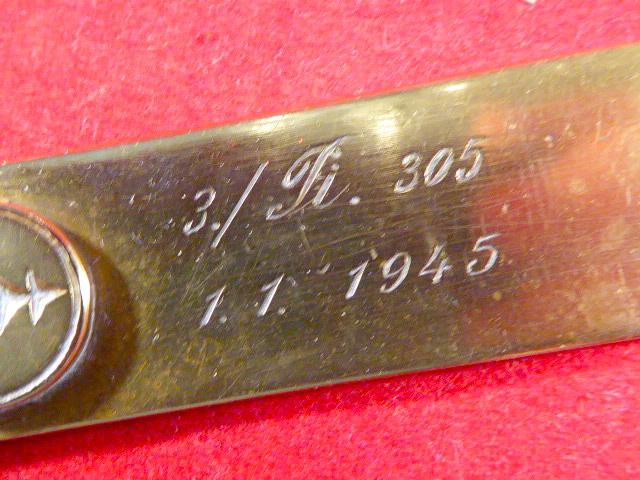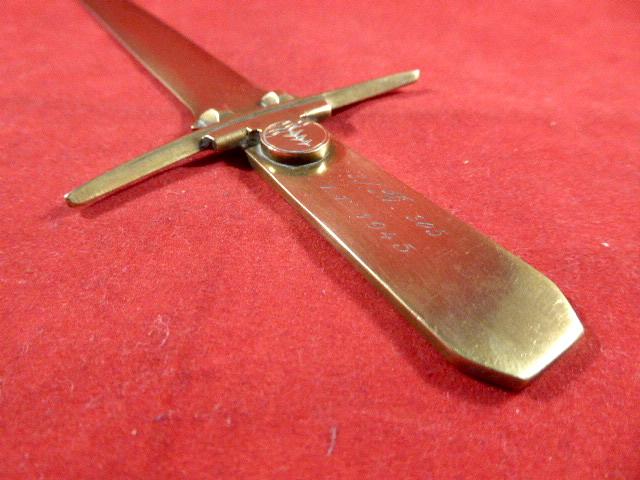Rare WW2 German army officer’s brass commemorative letter opener - 305th Infantry Division (Wehrmacht) 1945
Here on offer is a rare WW2 senior German army officer’s brass commemorative letter opener that relates to the renowned 305th Infantry Division (Wehrmacht).
The 305th Infantry Division (designated 305. Infanterie-Division in German) was a German Army unit that saw extensive, front-line action during World War II. This division was present at the Battle of Stalingrad, the Battle of Monte Cassino, and surrendered to U.S. Army's 88th Infantry Division in Northern Italy near Trento in late April 1945.
The division has been implicated in a number of war crimes in Italy between October 1943 and April 1945, with up to twelve civilians executed in each incident.
The brass letter opener is in excellent condition and has been made from two pieces; the crossguard has been flush riveted to the blade and grip section.
On the front it displays the round “tree and 3 wavy lines” insignia for the German 305th Infantry Division.
The front of the flat grip has been engraved in gothic text with the following:
3./ Ti. 305
1.1. 1945
I think the top line refers to a regiment of the 305th division and clearly the lower line is a relevant date?
On the reverse of the grip is the engraved image of an unusual anchor, the style of which seems to relate to the type the Italian Navy (Battleship Section) used at that time?
I have tried to research the relevance of this and the date but as yet apart from the 305th where located at Bologna, Northern Italy during this period, that is all I can find.
Below is some information relating to the divisions actions during late 1944 and 1945.
Italy late 1944.
By September 10, the division was deployed along the new defensive line. Throughout the month of October 1944 the 305th Infantry Division was engaged in heavy defensive fighting on the arc of the front south of Faenza and in November 1944 returned to Lamone near Faenza. Heavy defensive fighting broke out again in December. On December 10, the worn-out division was replaced by the 90th Panzer Grenadier Division and moved to the Imola area.
On the heights between Pidéura and Senio, the I./ GR 578, the II./ GR 577 and the I./ GR 576 came under the command of the Staff of Grenadier Regiment 578 with troops from the regiment. On December 14, these parties were hit by another Allied attack and had to withdraw behind the Senio on the night of December 16.
On December 17, 1944, the 305th Infantry Division withdrew from the front lines and was transferred to the area west of Bologna to reorganize. The division was then redeployed to the Faenza area. They took up positions on the heights southwest of Faenza on the Lamone.
During the night of December 19, the deployed parts of the division were replaced by Panzer Grenadier Regiment 200. On December 22, the 305th Infantry Division was converted to Army Group Reserve and moved into an area of accommodation 20 km west of Bologna.
Actions in 1945.
In early January 1945, the division re-joined the front line and took up a position immediately southeast of Bologna, south of Via Emilia. The division's right neighbour was the 65th Infantry Division and the 1st Parachute Division was on the right. The division remained here until early April, with repeated Allied reconnaissance advances.
On April 9, 1945, the Allied spring offensive against the German positions on the Senio began. After the positions of the I. Parachute Corps were penetrated there, the division had to withdraw to Bologna on April 18. On April 19, the division withdrew behind Savena and on the night of April 21 to the plain north of Via Emilia, east of central Bologna.
Along with the 65th Infantry Division, the division continued its retreat towards the Po and was completely crushed on April 24, 1945. Only a few remaining elements were able to settle on the Po River, the mass, including the Unit Staff, marched into captivity.
It measures 9.3” (23.8cm) long and weighs 60g.
Please see my pictures for the details of the condition, which complement this description.
Please see my TERMS OF BUSINESS regarding Deliver Charges and Insurance regarding additional insurance cover, should you require it, BEFORE the item is dispatched.
The responsibility lies with the customer to check with your Customs restrictions that this item can be imported into your country.
Code: 50913










